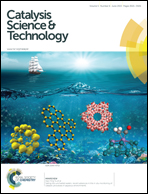CdS-decorated triptycene-based polymer: durable photocatalysts for hydrogen production under visible-light irradiation†
Abstract
A series of cadmium sulfide (CdS)/triptycene-based polymer (NTP) nanocomposites was fabricated via a facile precipitation process by using Cd(OAc)2, Na2S, and prefabricated NTP as raw materials. The photocatalytic hydrogen-generating capabilities of the novel CdS-NTP nanocomposites have been investigated in the presence of a sacrificial reagent. After hybridization with NTP, the rate of visible-light-driven hydrogen production of CdS-NTP is 10 times higher than that of pure CdS prepared under the same conditions. The photocorrosion of CdS is simultaneously suppressed and the composites show high stability. The high surface area and stable covalent structure of NTP confines the CdS quantum dots and prevents aggregation, thus increasing the catalytically active sites and enhancing the photocatalytic performance of the hybrid nanocomposites. This work demonstrates a high potential of using porous triptycene-based materials to develop multifunctional porous materials for semiconductor-based photocatalytic hydrogen evolution.


 Please wait while we load your content...
Please wait while we load your content...